Maria I of Portugal Worksheets
Do you want to save dozens of hours in time? Get your evenings and weekends back? Be able to teach about Maria I of Portugal to your students?
Our worksheet bundle includes a fact file and printable worksheets and student activities. Perfect for both the classroom and homeschooling!
Resource Examples
Click any of the example images below to view a larger version.
Fact File
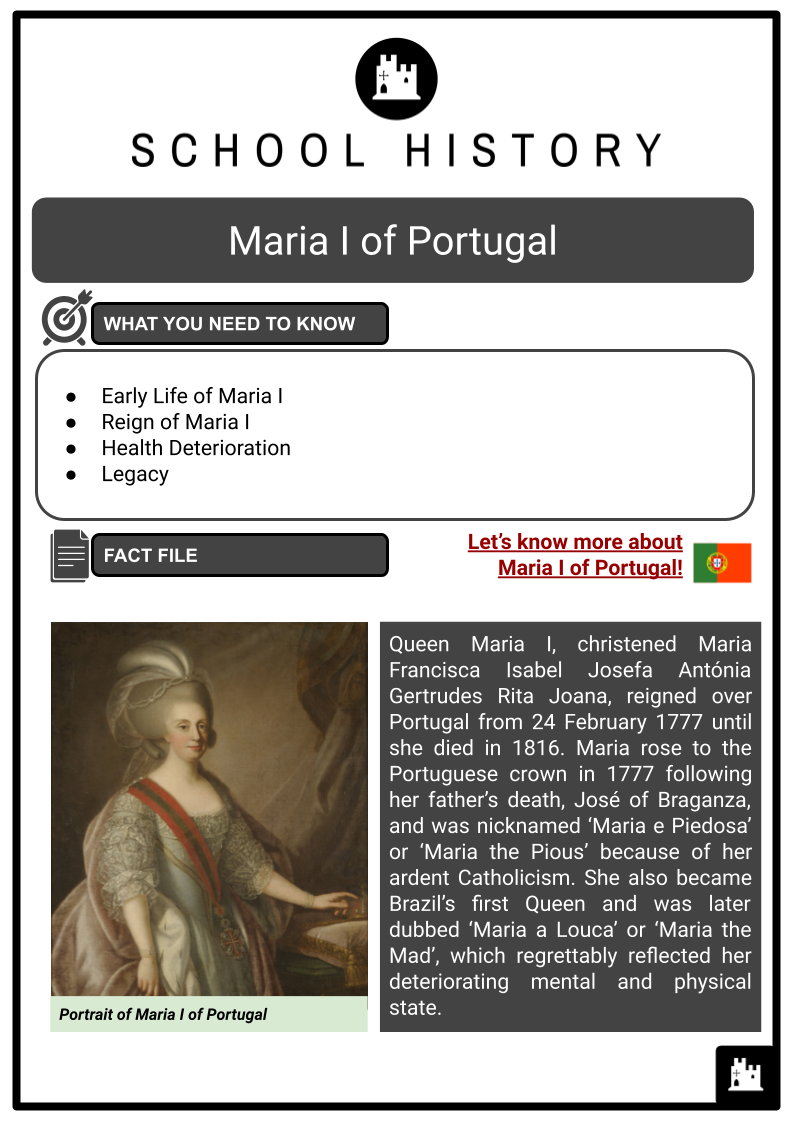
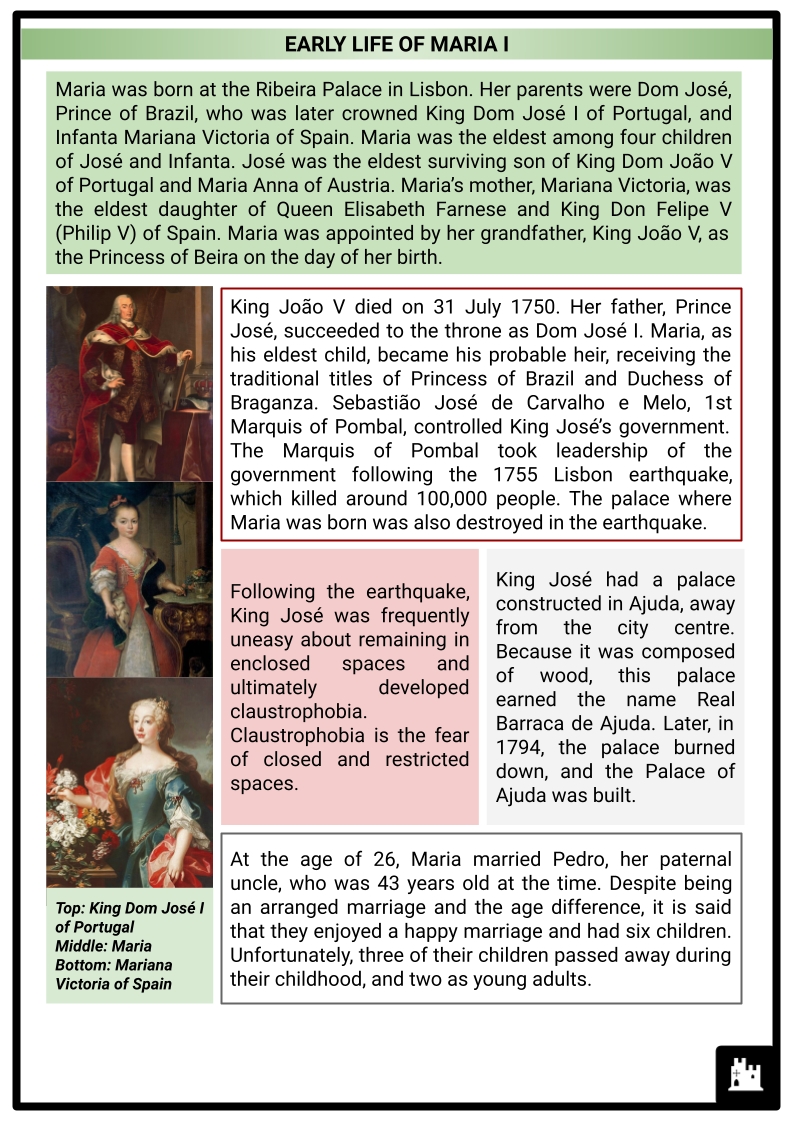
Student Activities
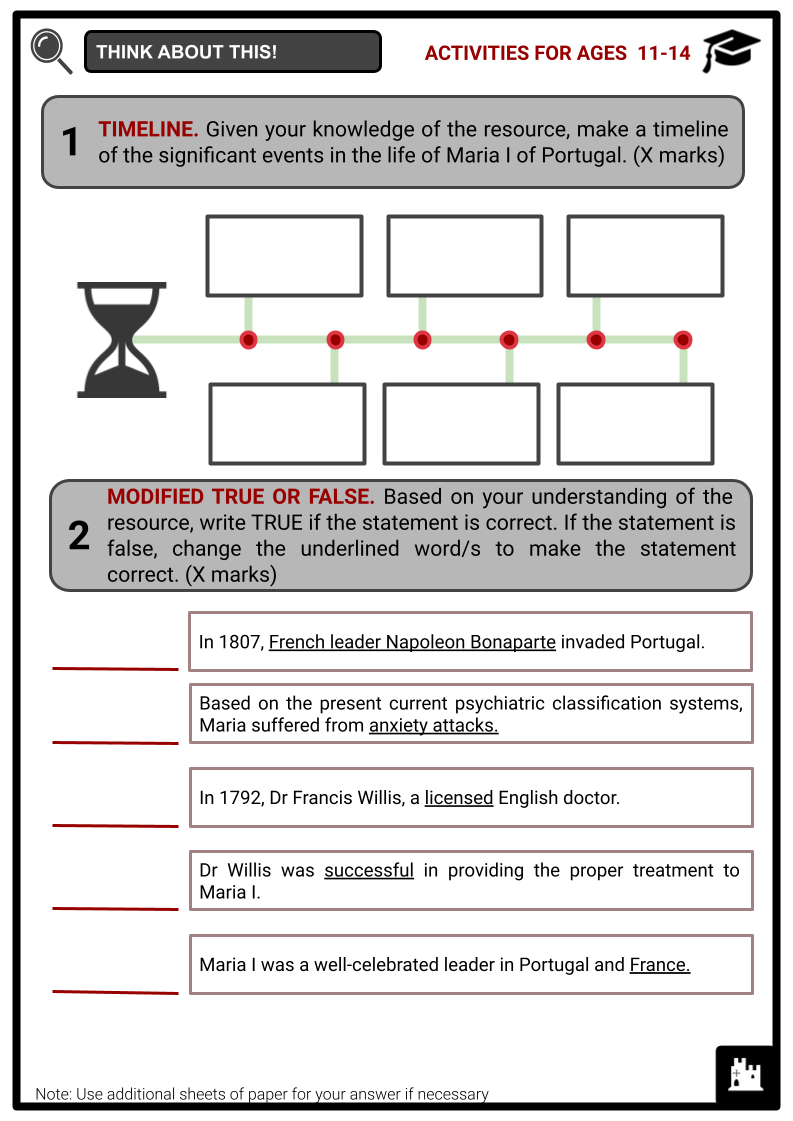
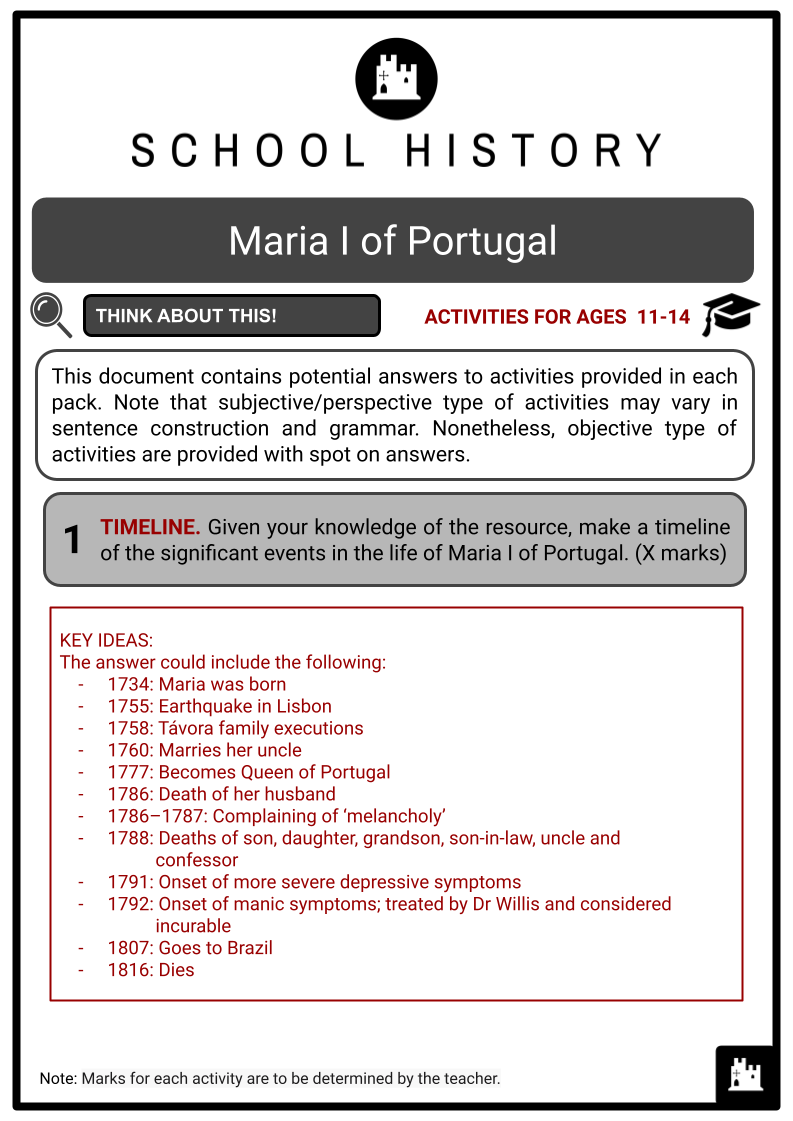
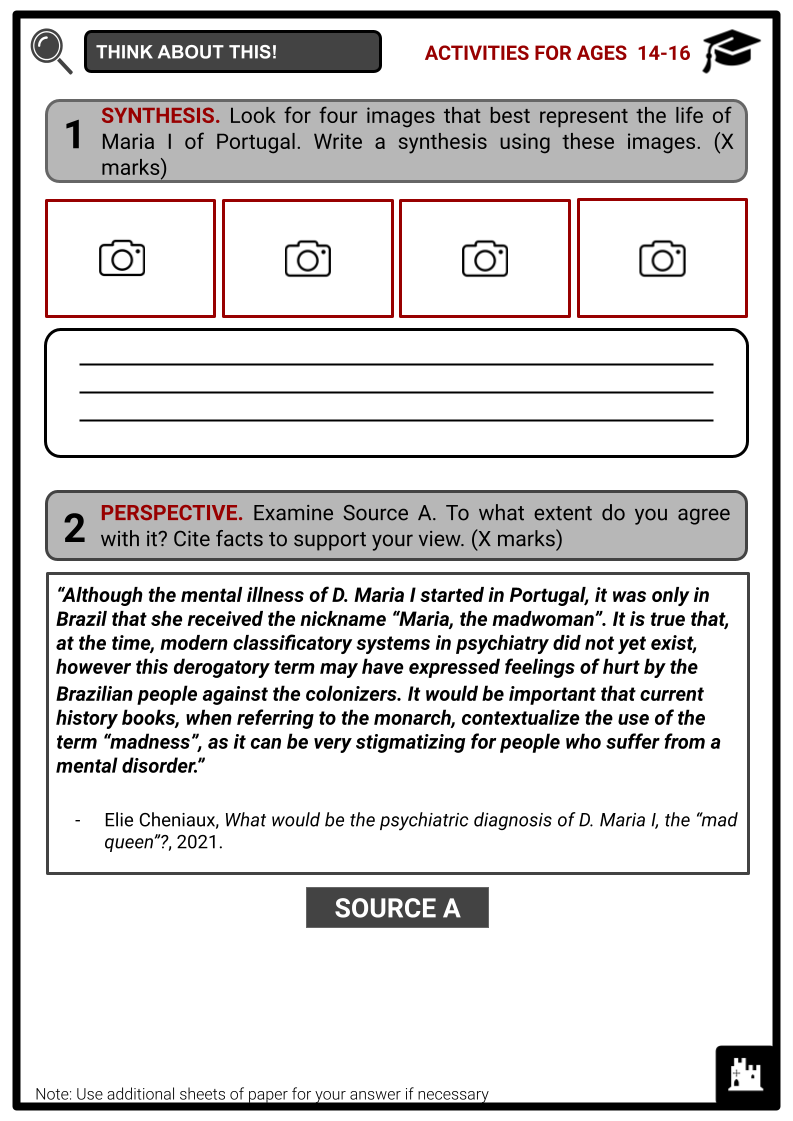
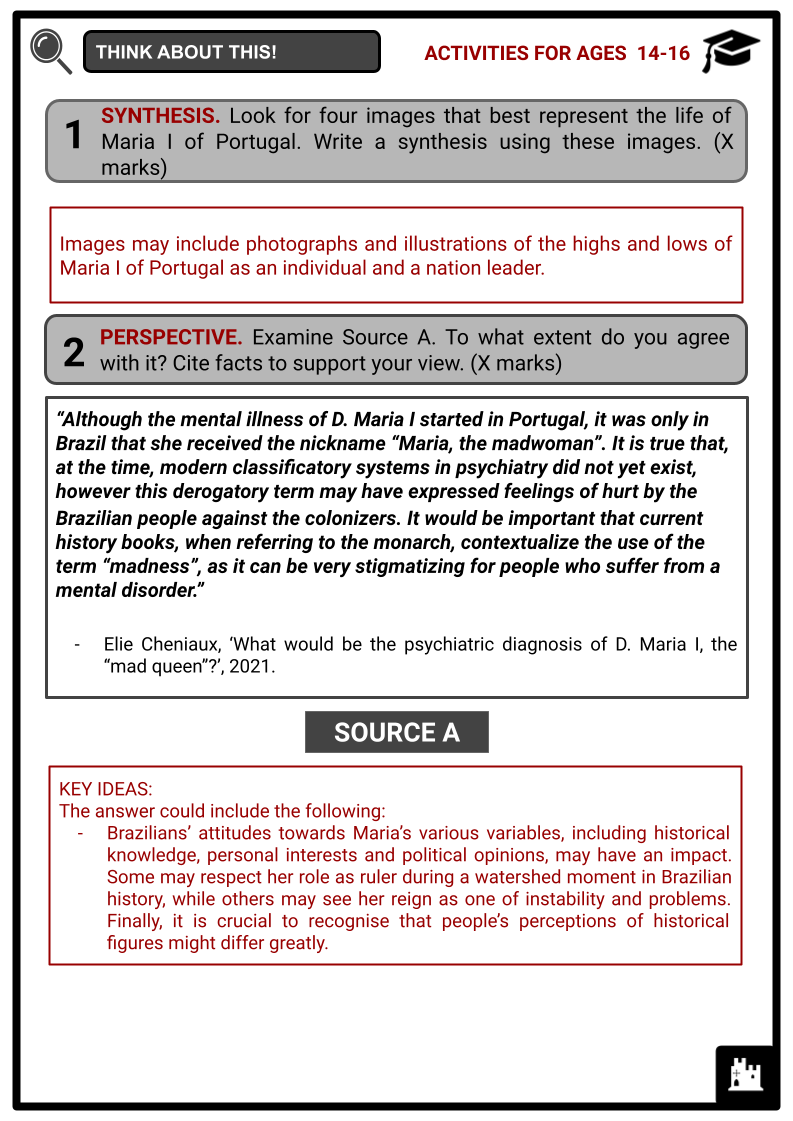
Summary
- Early Life of Maria I
- Reign of Maria I
- Health Deterioration
- Legacy
Key Facts And Information
Let’s know more about Maria I of Portugal!
Queen Maria I, christened Maria Francisca Isabel Josefa Antónia Gertrudes Rita Joana, reigned over Portugal from 24 February 1777 until she died in 1816. Maria rose to the Portuguese crown in 1777 following her father’s death, José of Braganza, and was nicknamed ‘Maria e Piedosa’ or ‘Maria the Pious’ because of her ardent Catholicism. She also became Brazil’s first Queen and was later dubbed ‘Maria a Louca’ or ‘Maria the Mad’, which regrettably reflected her deteriorating mental and physical state.
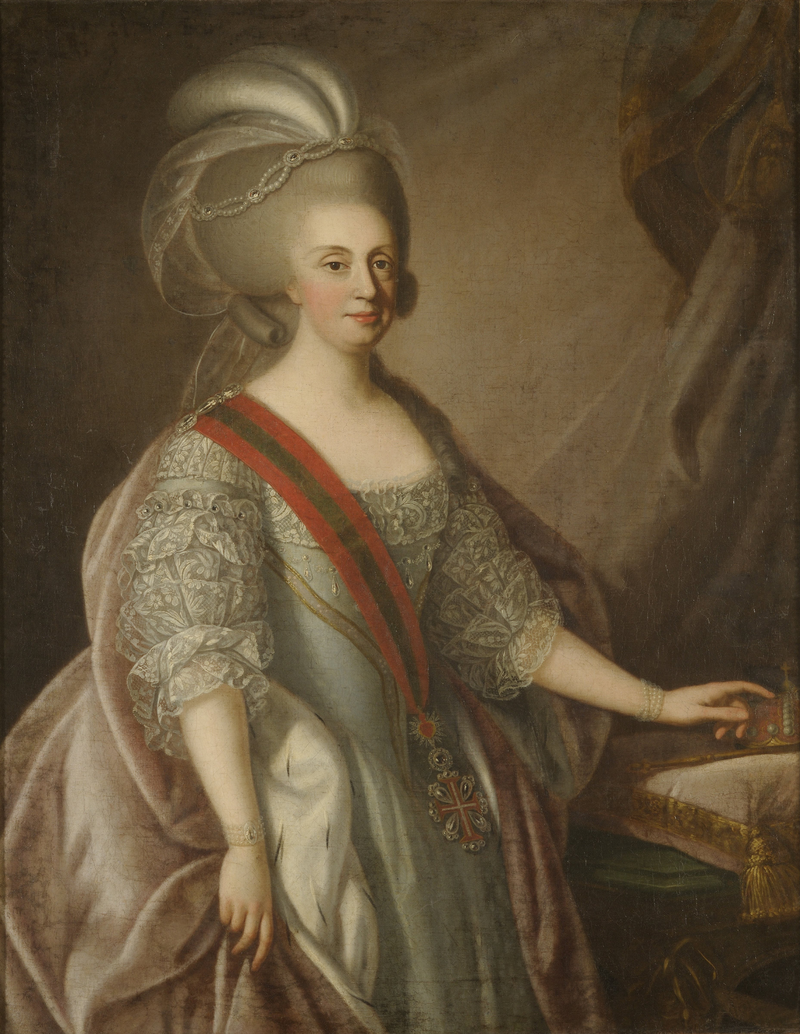
EARLY LIFE OF MARIA I
- Maria was born at the Ribeira Palace in Lisbon. Her parents were Dom José, Prince of Brazil, who was later crowned King Dom José I of Portugal, and Infanta Mariana Victoria of Spain. Maria was the eldest among four children of José and Infanta. José was the eldest surviving son of King Dom João V of Portugal and Maria Anna of Austria. Maria’s mother, Mariana Victoria, was the eldest daughter of Queen Elisabeth Farnese and King Don Felipe V (Philip V) of Spain. Maria was appointed by her grandfather, King João V, as the Princess of Beira on the day of her birth.
- King João V died on 31 July 1750. Her father, Prince José, succeeded to the throne as Dom José I. Maria, as his eldest child, became his probable heir, receiving the traditional titles of Princess of Brazil and Duchess of Braganza. Sebastião José de Carvalho e Melo, 1st Marquis of Pombal, controlled King José’s government. The Marquis of Pombal took leadership of the government following the 1755 Lisbon earthquake, which killed around 100,000 people. The palace where Maria was born was also destroyed in the earthquake.
- Following the earthquake, King José was frequently uneasy about remaining in enclosed spaces and ultimately developed claustrophobia. Claustrophobia is the fear of closed and restricted spaces.
- King José had a palace constructed in Ajuda, away from the city centre. Because it was composed of wood, this palace earned the name Real Barraca de Ajuda. Later, in 1794, the palace burned down, and the Palace of Ajuda was built.
- At the age of 26, Maria married Pedro, her paternal uncle, who was 43 years old at the time. Despite being an arranged marriage and the age difference, it is said that they enjoyed a happy marriage and had six children. Unfortunately, three of their children passed away during their childhood, and two as young adults.
REIGN OF MARIA I
- King José died on 24 February 1777. Maria became Portugal’s first indisputable Queen regnant. With Maria’s succession, her husband became King Pedro III, but the actual regal authority rested completely with Maria, the crown’s lineal heir. Furthermore, because Pedro’s monarchy was solely jure uxoris, his rule would expire with Maria’s death, and the throne would pass to Maria’s descendants. Jure uxoris is a noble title a man holds because his wife occupies the office.
- Maria I is thought to have been a good queen during the early years of her reign. Her first act as a queen was to dismiss the popular secretary of state of the country, the Marquis of Pombal, who had shattered the authority of the reactionary aristocracy through the Távora crisis. Pombal ordered the execution of all the members of the Távora family, and it was only because of the intervention of Maria I and her mother that some women and children were spared.
- The Távora affair was a political controversy in the 18th-century Portuguese court. The events that began with the attempted assassination of King José in 1758 culminated in the public execution of the entire Távora family, their closest relatives and several servants in 1759. After eliminating Pombal, Maria I reinstated the Távora family’s name in 1781 after a trial review.
- Noteworthy events of Marias I’s reign include Portugal’s membership in the League of Armed Neutrality, an alliance of European naval powers formed between 1780 and 1783 to protect neutral shipping from the British Royal Navy’s wartime policy of unlimited search of neutral shipping for French contraband during the American Revolutionary War and Anglo-French War.
- Under her reign, Lisbon’s Academy of Science and Royal Orphanage was created, and Maria I continued her father’s educational reforms. Her reign also saw the growth of a commercial upper-middle class, and business and trade flourished.
- On 5 January 1785, Maria I issued a policy imposing heavy restrictions on industrial activity in Brazil. This charter prohibited the manufacture of fabrics and other products, putting out all textile manufacturers in the colony, except the industry of coarse cloth for the use of enslaved workers, since the Portuguese colonial administration did not look favourably on the development of industrial activities in Brazil for fear of economic and, possibly, political independence.
- During Maria I’s reign, ensign Joaquim José da Silva Xavier, also known as Tiradentes, was tried, convicted and executed.
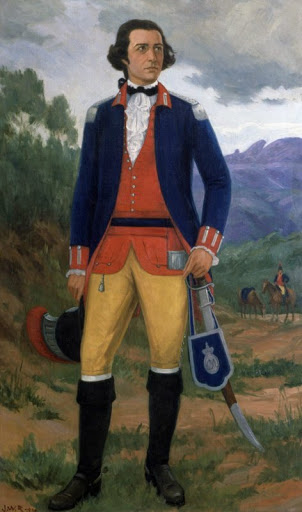
- Tiradentes planned to take to the streets of Vila Rica and proclaim the Brazilian Republic on February 1789, when taxes were due to Portugal, and sentiments of insurrection among Brazilians were strongest.
- Joaquim Silvério dos Reis, one of the conspirators, revealed the plan in exchange for a tax break. The governor of Minas Gerais decided to imprison the rebels.
- The trial lasted nearly three years. Tiradentes was sentenced to death alongside ten other people. Maria I later mitigated all capital punishment sentences to everlasting banishment, except those whose activities constituted severe conditions. Such was the situation with Tiradentes, who accepted full responsibility for the movement. He was imprisoned in Rio and executed on 21 April 1792. His body was then quartered, and the pieces were sent to Vila Rica to be displayed in locations where he used to spread his liberal ideals.
HEALTH DETERIORATION
- Unfortunately, Maria I’s achievements as Queen have received less attention than her ill health. The first description of Maria’s mental disorder mentions an incident of delirium in 1781. A considerable quantity of loss occurred both before and after this illness. Her husband died in May 1786 due to a thrombosis, and her eldest son, Prince Dom José, died from smallpox in September 1788.
- One crucial detail is that, despite receiving instruction, Maria avoided vaccination against smallpox for religious purposes. In November of the same year, the same sickness killed Mariana Vitoria, her daughter, as well as Vitoria’s newborn son and husband, Prince Gabriel de Bourbon of Spain. In the same month, Friar Ignatius of San Caetano, the Queen’s confessor, died from a thrombosis. In December 1788, Carlos III of Spain, Mariana Vitoria’s father-in-law and Maria I’s uncle, passed away, marking the sixth death in three years.
- Maria began writing about her feelings of melancholy. As cited in a research article entitled ‘Maria I: The losses and glories of the Queen who went down in history as “the Crazy”’, published in 2019:
“restlessness, [...] dry mouth, difficulty swallowing, blurred vision, tremors or heat waves and body aches….”
- Maria I began to exhibit more serious symptoms, most likely from a depressed state, in October 1791, when she was 56 years old. According to the report, she began to plunge into great melancholy, with nocturnal anguish, interrupted sleep and a sadness of spirit.
- In December of that same year, it was recorded that she was suffering from melancholy reflections, the malaise in her head and a very afflicted mind. Maria I, who had been active and exercised before, had become soft and passive and suffered from insomnia and a lack of appetite at the time.
- Maria I displayed significant emotions of guilt during her depression, which were most likely erroneous. She felt sinful and, therefore, declined communion. She felt she was responsible for all of the world’s evils and had failed in her obligations. She claimed that the deaths of her children, grandchildren and loved ones were divine retribution for her misdeeds. It is conceivable that the formation of these illusions was influenced, at least in part, by her new confessor, Monsignor José Maria de Melo, the bishop of the Algarve, who continually pressed her to rehabilitate and forgive the survivors of the Távora massacre.
- In a research article entitled ‘What would be the psychiatric diagnosis of D. Maria I, the “mad queen”?’ published in 2021, Maria had a ‘fit’ during a performance at the theatre. After being carried home, she shouted and moaned throughout the night, wandering from side to side, pulling her hair and speaking incoherently. Her talks were sometimes of a low-caste nature.
- At other times, she was cheerful and sang, which was unusual. Maria I received a variety of treatments throughout the years, all of which proved ineffective. In addition to sulphurous water baths, diets, enemas and the consumption of quinine and valerian, she experienced regular bleeding. In 1792, Dr Francis Willis, an unlicensed English doctor, was summoned to Lisbon to treat Maria. Willis was the same person who treated King George III of England.
- Willis advocated for moral treatment (psychotherapy) and sufficient diet above medication, and the first results were promising. However, unlike his treatment of George III, his role was to advise rather than have complete control over Maria’s care.
- Willis’s approach proved unsatisfactory: his attempts to release Maria from the pressures of court life, including a sea cruise, were foiled when all her couriers and government officials insisted on accompanying her. Jenifer Roberts, Maria I’s biographer, mentions the use of straitjackets, cold water baths, ointments and enemas, in addition to vomit induction during the treatment process.
- Willis proclaimed Maria incurable and advised her to continue receiving therapy from physicians at the University of Coimbra. Because of Maria’s condition, her second-born son, Prince João, took over the government in her name. In 1799 João was legally recognised as prince regent, although having governed since 1792.
- There were several incidences of mental disorders in Maria I’s household, which included many inbred marriages. Mariana and Dorothea, two of Maria I’s three sisters, also suffered from mental disorders.
- During Maria I’s reign, the Catholic Church promoted the belief that mental illness was caused by demonic possession. Doctors at the time still believed in the humoral theory that melancholy was caused by black bile accumulation. This justified the Portuguese Queen’s purgative treatments and bleeding.
- Despite the scarcity of evidence about Maria I’s mental illness, the accounts of her complaints and behavioural changes strongly suggest that she experienced multiple depressed and manic episodes, each accompanied by psychotic symptoms. Therefore, based on current psychiatric classification systems, the most likely diagnosis is Bipolar disorder.
- In 1807, French leader Napoleon Bonaparte invaded Portugal, and with British encouragement, the whole House of Braganza fled to Brazil, which was then a colony of Portugal. Maria became known in Brazil as ‘Maria a Louca’ or ‘Maria the Mad’, which was unfortunate given her deteriorating mental and physical health. In 1815, Prince João’s government made Brazil a kingdom, and Maria was named Queen of the United Kingdom of Portugal, Brazil, and the Algarves.
- When Napoleon was defeated in 1815, Maria and her family stayed in Brazil. Maria I died of cardiovascular problems in March 1816, aged 82. After Maria’s death, the prince regent became King Dom João VI. In 1821, her body was returned to Lisbon and placed in a mausoleum at the Estrela Basilica, which she had helped found.
LEGACY
- Maria is a revered figure in Brazil and Portugal because of the monumental changes and events during her reign. In Portugal, she is revered as a powerful female character. Her impact is visible in Portugal’s Queluz Palace, a baroque-rococo masterpiece she helped design. To honour her name, a big statue can be found in front of the palace, and a pousada can be found near the palace.
- In Brazil, Maria is regarded as a pivotal character in Brazil’s ultimate independence. Many of Brazil’s national institutions and organisations were established during her reign, albeit under her son’s regency. These institutions predated their modern counterparts and gave the Brazilian colonials significant influence.
Frequently Asked Questions
- Who was Maria I of Portugal?
Maria I, also known as Maria the Pious or Maria the Mad, was the Queen of Portugal from 1777 until she died in 1816. She was one of the most significant monarchs in Portuguese history.
- What is Maria I best known for?
Maria I is best known for her reign during a period of significant political and social upheaval in Portugal, particularly the loss of Brazil as a colony and her struggle with mental condition.
- How did Maria I's mental condition affect her rule?
Maria I's mental condition had a profound impact on her ability to govern effectively. During periods of clarity, she attempted to assert control over affairs of state, but her episodes of mental instability often necessitated the appointment of regents to govern in her stead.
